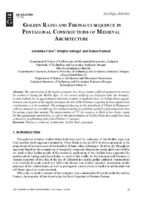Golden Ratio and Fibonacci Sequence in Pentagonal Constructions of Medieval Architecture

Megtekintés/
Metaadat
Teljes megjelenítés
Link a dokumentumra való hivatkozáshoz:
Gyűjtemény
Absztrakt
The construction of the regular pentagon has always meant a difficult geometrical exercise for architects during the Middle Ages. As the correct drafting was forgotten after the Antiquity, several methods for its approximation had been invented in medieval times. As Golden Ratio appears between several parts of the regular pentagon, the role of the Fibonacci sequence in these approximate constructions is to be examined. The pentagonal drawing in the sketchbook of Villard de Honnecourt calls our attention to a possible way how medieval architects could have applied simple numerical ratios for getting angles they needed. The approximation of 72°, for instance, is likely to have been crucial for this pentagonal construction, as well as the approximation of Golden Ratio that could have been achieved by neighbouring pairs from Fibonacci’s sequence.
- Cím és alcím
- Golden Ratio and Fibonacci Sequence in Pentagonal Constructions of Medieval Architecture
- Szerző
- Fehér, Krisztina
- Szilágyi, Brigitta
- Halmos, Balázs
- Megjelenés ideje
- 2018
- Hozzáférés szintje
- Open access
- ISSN, e-ISSN
- 2064-2520
- Nyelv
- en
- Terjedelem
- 10 p.
- Tárgyszó
- Fibonacci, medieval, architecture, Golden Ratio, pentagon
- Változat
- Kiadói változat
- A cikket/könyvrészletet tartalmazó dokumentum címe
- YBL Journal of Built Environment
- A forrás folyóirat éve
- 2018
- A forrás folyóirat évfolyama
- 6. évf.
- A forrás folyóirat száma
- 1. sz.
- Műfaj
- Tudományos cikk
- Tudományterület
- Művészetek - építőművészet
- Egyetem
- Óbudai Egyetem
- Kar
- Ybl Miklós Építéstudományi Kar
